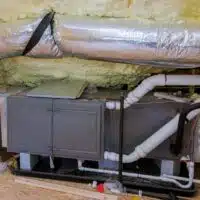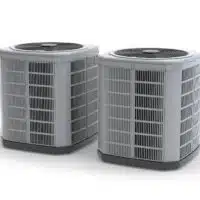Common Ductwork Problems in Homes
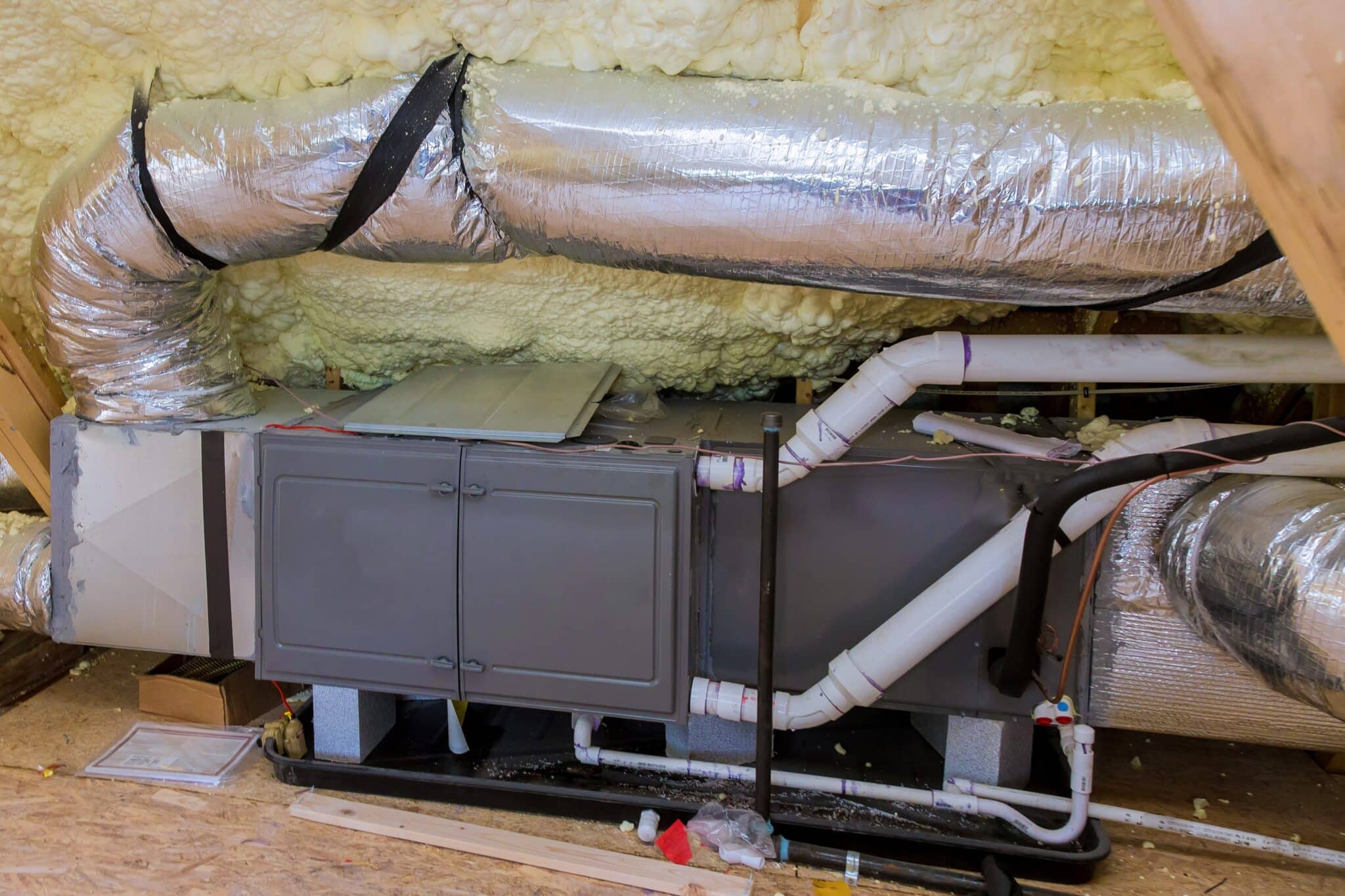
Are you noticing rising energy bills, uneven temperatures, or musty odors in your home? These signs often indicate ductwork problems affecting your HVAC system’s efficiency. Issues like leaks, poor insulation, or blockages force the system to work harder, driving up costs and reducing comfort.
Addressing these common problems can improve air quality, lower bills, and extend the system’s lifespan, making it a smart investment in your home’s comfort and efficiency.
Air Leakage
Air leakage is a common yet costly ductwork problem that can severely impact HVAC efficiency and home comfort. Even minor leaks in duct connections or seals allow conditioned air to escape, which forces your HVAC system to work harder, especially during colder months. Here’s why air leakage matters and how to address it effectively:
Causes of Air Leakage
- Aging Seals and Materials: Over time, seals around duct connections wear out, allowing air to seep through weak points.
- Loose Connections: Sections of ductwork can loosen or disconnect due to natural vibration or shifting over time.
- Poor Initial Installation: Ductwork that wasn’t properly secured during installation is more prone to leakage later on.
Impacts of Leakage
- Increased Energy Bills: As air leaks out, your HVAC works harder to compensate, which can spike your energy costs by as much as 30%.
- Uneven Heating and Cooling: Air doesn’t reach all rooms evenly, leading to hot or cold spots throughout your home.
- Reduced Indoor Air Quality: Leaks allow contaminants like dust and allergens to enter the system, impacting the quality of circulated air.
Solutions to Prevent Air Leakage
- Seal with Professional-Grade Materials: Use HVAC-specific tapes or mastic sealants on small gaps for an affordable fix.
- Professional Inspection: For widespread issues, HVAC professionals use diagnostic tools to locate leaks and apply durable seals that enhance efficiency.
- Regular Maintenance: Routine seasonal inspections help catch new leaks early, keeping your HVAC system efficient and extending its life.
Investing in air leakage prevention not only keeps your home comfortable but also reduces energy costs over time, making it a smart move for homeowners.
Improper Design or Installation
Improper design or installation is one of the most common ductwork problems in Surprise, AZ, as it directly impacts both airflow and energy efficiency. Poorly designed ductwork leads to inconsistent temperatures and reduced airflow across rooms, with issues like sharp bends, narrow sections, or poorly sealed connections disrupting the HVAC system’s circulation.
In Surprise’s climate, this problem forces the HVAC to work harder, driving up energy bills and accelerating system wear. Addressing these issues with a professional duct inspection can optimize airflow, reduce energy costs, and extend the HVAC system’s lifespan by correcting inefficient design elements.
Recognizing Key Ductwork Problems
- Temperature Imbalance: If certain rooms are always warmer or cooler than others, this imbalance is likely due to poorly designed ducts. Uneven airflow means some areas don’t receive enough conditioned air, creating discomfort and higher energy costs.
- Reduced Airflow from Installation Errors: Poor installation, like unnecessary bends or narrow ducts, limits airflow. This restriction causes the HVAC system to work harder and consume more energy to maintain temperature, leading to higher bills and a shorter system lifespan.
Solutions to Address Ductwork Problems
A professional inspection before peak HVAC usage is essential. HVAC technicians can assess the layout, recommending adjustments such as widening narrow ducts, reducing bends, and adding insulation to ensure efficient airflow.
Regular seasonal maintenance can also help catch and resolve ductwork problems early, ensuring consistent comfort and reduced energy costs throughout your home.
Opting for quality ductwork solutions not only enhances comfort but also brings lasting savings by reducing energy costs, making it a smart decision for any homeowner.
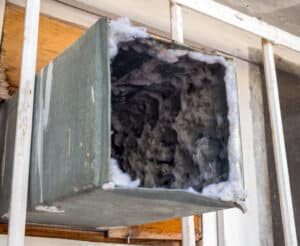
Dirty or Blocked Ducts
Dirty or blocked ducts are one of the most impactful ductwork problems affecting HVAC efficiency and indoor air quality. Over time, ducts accumulate dust, pollen, pet dander, and other debris, which obstructs airflow and reduces the system’s ability to maintain a comfortable indoor temperature.
This buildup forces the HVAC system to work harder, leading to increased energy costs and adding strain to system components. As a result, homeowners face both higher utility bills and the likelihood of more frequent repairs due to accelerated system wear.
Health and Efficiency Impacts
- Poor Indoor Air Quality: When ducts are clogged, contaminants like dust and allergens circulate every time the HVAC system runs. This can worsen respiratory issues, allergies, and asthma by lowering indoor air quality. Circulating particles also create more cleaning needs, as dust settles around the home more frequently.
- Reduced System Efficiency: Blocked ducts require the HVAC system to expend more energy to push air through, which limits effective heating or cooling. This inefficiency can lead to hot and cold spots within the home, where airflow cannot be reached consistently, and it increases monthly utility bills due to the added energy demand.
Importance of Fall Duct Cleaning
A thorough duct cleaning each fall is a proactive way to address ductwork problems and prepare the HVAC system for heavier winter use. Clearing out accumulated debris improves airflow, enabling the system to heat the home more effectively and efficiently. Seasonal duct cleaning also removes harmful allergens and dust buildup, promoting healthier indoor air quality during the colder months when homes are more sealed.
By tackling this essential maintenance step before winter, homeowners can enjoy a more comfortable, cost-effective, and health-conscious home environment. Addressing ductwork problems like buildup and blockages early ensures optimal system performance and helps prevent costly repairs.
Poor Insulation
Poor insulation is a significant ductwork problem that impacts energy efficiency and home comfort. Without adequate insulation, especially in unconditioned areas like attics or crawl spaces, ducts allow heated air to escape, causing the HVAC system to work harder to maintain desired temperatures. This inefficiency leads to higher utility bills, with homeowners unknowingly paying for wasted heat that never reaches living areas. During colder months, this ductwork problem is especially costly, as it places additional stress on the HVAC system, accelerating wear and resulting in more frequent repairs.
Increased Heating Costs
With insufficient insulation, the HVAC system must cycle on more frequently to compensate for lost heat, significantly increasing winter energy bills. The added workload from this ductwork problem also means components experience faster wear, reducing the system’s lifespan and reliability over time.
Uneven Room Temperatures
Poor insulation often causes temperature inconsistencies, with rooms farther from the HVAC unit feeling colder. This imbalance forces the system to overcompensate by using more energy to heat under-insulated areas, leading to additional energy waste and a less comfortable living environment.
Effective Insulation Solutions
The best way to address this ductwork problem is to add high-quality insulation materials like fiberglass or foam around ducts. These materials create a barrier that retains heat, allowing warm air to reach living spaces effectively and reducing HVAC energy consumption.
For optimal results, an HVAC technician can evaluate insulation needs and apply insulation where it’s needed most. By addressing this ductwork problem before winter, homeowners can enjoy lower heating costs, improved indoor comfort, and a longer-lasting HVAC system
Solving poor insulation issues provides long-term comfort and savings, making it a wise investment for any homeowner seeking to improve energy efficiency and reduce repair costs.
Disconnected or Damaged Ducts
Disconnected or damaged ducts are common ductwork problems that can severely impact the efficiency and effectiveness of a home’s HVAC system. When ducts become detached or suffer damage, air leaks occur, preventing heated or cooled air from reaching intended rooms. This leakage forces the HVAC system to work harder, which drives up energy bills and shortens the system’s lifespan due to the added strain.
These ductwork problems are often caused by age, poor initial installation, or external damage, such as from pests or renovations. Over time, even minor disconnections can lead to significant efficiency losses, making them costly if left unaddressed.
Increased Energy Costs
With disconnected or damaged ducts, a significant amount of conditioned air escapes into spaces like attics or crawl areas rather than circulating through living spaces. This leakage forces the HVAC system to run more frequently, which can increase utility bills by as much as 20-30% over time. Homeowners often overlook this ductwork problem, not realizing the cost it adds to their monthly energy expenses.
Inconsistent Room Temperatures
Disconnected ducts often lead to uneven temperature distribution throughout the home. Rooms farther from the HVAC unit may feel colder or warmer due to air loss in damaged sections. This inconsistency not only reduces comfort but also puts additional pressure on the HVAC system to balance temperatures, which increases wear on components.
Effective Solutions for Disconnections and Damage
Repairing or reconnecting damaged ducts is essential for restoring HVAC efficiency. A professional HVAC technician can inspect the entire duct system, seal leaks, and reconnect any loose or damaged sections.
In cases of severe wear or damage, replacing sections of ductwork may be necessary to ensure optimal performance. Addressing this ductwork problem promptly helps homeowners maintain a comfortable and efficient home environment while reducing overall energy expenses.
By fixing disconnected or damaged ducts, homeowners can enjoy more consistent indoor temperatures, reduced energy costs, and a longer-lasting HVAC system, making it a valuable investment in home comfort and efficiency.
Microbial Growth Concerns
Microbial growth within ductwork is one of the more serious ductwork problems that can affect indoor air quality and HVAC efficiency. Mold, mildew, and bacteria thrive in damp conditions, often forming in ducts due to condensation from temperature differences or from leaks within the duct system.
In Phoenix-area homes, the problem is especially relevant during cooler months, as indoor humidity levels rise, creating an ideal environment for microbes to grow. When these contaminants spread through the HVAC system, they can circulate harmful spores throughout the home, worsening respiratory issues, allergies, and other health concerns for household members.
Causes of Microbial Growth
Moisture accumulation is the primary cause of microbial growth in ductwork, often due to leaks or condensation when cool air meets warm, unconditioned air. Inadequate sealing or aging ducts can exacerbate these ductwork problems, trapping moisture within the system and accelerating microbial spread.
Solutions for Long-Lasting Prevention
Addressing these ductwork problems requires both immediate action and preventive strategies. A professional duct cleaning can remove existing mold and mildew, restoring cleaner airflow and reducing health risks.
For ongoing prevention, installing UV light systems within the ductwork is highly effective. UV lights kill bacteria, mold, and mildew, preventing regrowth as air circulates. Additionally, managing indoor humidity with a dehumidifier can limit microbial development, creating a less hospitable environment for growth.
Proactively tackling these ductwork problems with cleaning and UV technology significantly improves air quality, enhances HVAC efficiency, and creates a healthier living environment. Investing in these measures ensures long-term comfort, fewer repairs, and peace of mind throughout the year.
Inadequate Airflow
Inadequate airflow is one of the most common ductwork problems that impacts both HVAC efficiency and overall indoor comfort. Restricted airflow often stems from poor duct design—such as sharp bends, overly long runs, or narrow sections—hindering the movement of air throughout the system.
Additionally, blockages caused by dust buildup, debris, or disconnected sections can exacerbate this issue, forcing the HVAC system to work harder to maintain desired temperatures. These ductwork problems increase energy bills and place excessive wear on the system, ultimately shortening its lifespan.
Recognizing Inadequate Airflow
Common signs of restricted airflow include cold spots in certain rooms and extended operation times for the HVAC system. Cold spots indicate areas where airflow is limited, creating uneven temperatures throughout the home.
As the HVAC system cycles on and off more frequently to compensate for these inconsistencies, it consumes more energy, which raises utility bills and accelerates system wear. Early intervention to address these ductwork problems is crucial to maintain efficiency and comfort.
Professional Solutions for Improved Airflow
Addressing inadequate airflow effectively requires a professional duct inspection. HVAC technicians can identify design flaws and pinpoint blockages, providing targeted solutions such as widening narrow sections, removing obstructions, and sealing leaks.
By resolving these ductwork problems through professional adjustments, homeowners can benefit from consistent indoor temperatures, reduced energy costs, and a longer-lasting HVAC system. Regular inspections and maintenance ensure a balanced, efficient system that enhances comfort and provides cost savings throughout the year.
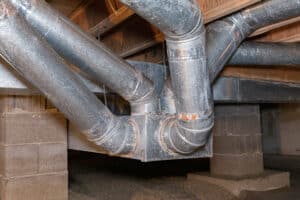
Old or Outdated Ductwork
Old or outdated ductwork is one of the most impactful ductwork problems that can severely affect HVAC efficiency, lead to increased repairs, and drive up energy costs. As duct systems age, they tend to develop leaks, cracks, and loose connections, causing significant air loss.
These issues require the HVAC system to work much harder to maintain comfortable temperatures, which results in higher utility bills and added strain on HVAC components. Over time, this increased strain can lead to more frequent repairs, making outdated ductwork both costly and inefficient. Aging ducts also accumulate dust, debris, and other pollutants, further restricting airflow and degrading indoor air quality, posing additional health concerns.
Addressing these ductwork problems by replacing outdated ducts before winter is highly recommended. As temperatures drop, the demand for heating rises and the inefficiencies of old ductwork become even more noticeable.
This can cause energy bills to surge and increase the likelihood of HVAC system breakdowns during the colder months.
Upgrading to a modern duct system not only optimizes airflow but also provides better insulation and minimizes leaks, making it a smart investment for reducing energy costs and enhancing comfort.
A professional HVAC technician can assess the condition of existing ductwork and recommend necessary replacements or upgrades to address these ductwork problems effectively.
By updating ducts before winter, homeowners benefit from improved heating efficiency, reduced energy expenses, and a more reliable HVAC system. Tackling these ductwork problems in advance ensures a more comfortable home environment, healthier indoor air, and long-term savings.
Addressing ductwork problems like poor design and blockages is essential for efficient airflow and lower energy costs. One Hour Air Conditioning & Heating of Phoenix, AZ provides expert solutions to keep your ductwork performing optimally and your home comfortable year-round.
FAQS About Ductwork Problems
-
How often should I have my ducts professionally cleaned?
Generally, ducts should be cleaned every 3–5 years to prevent ductwork problems like dust buildup, which can obstruct airflow and decrease efficiency. Homes with pets or residents with allergies may benefit from more frequent cleaning to maintain healthier air quality and prevent airflow restrictions.
-
What are cost-effective ways to improve duct efficiency without a full replacement?
Sealing leaks and adding insulation are both affordable solutions that enhance duct efficiency and reduce energy loss. These upgrades address common ductwork problems such as heat loss and leaks, which often lead to higher energy costs and uneven heating or cooling within the home.
-
What signs indicate my ductwork may need professional attention?
Common indicators of ductwork problems include uneven temperatures between rooms, musty or stale odors, increased dust levels, and a noticeable rise in energy bills. Such issues often signal leaks, microbial growth, or inadequate insulation, all of which can be resolved through professional inspection and maintenance.
-
Can regular duct cleaning help reduce energy costs?
Yes, regular duct cleaning improves airflow and prevents ductwork problems caused by dust and debris buildup. This not only keeps the HVAC system efficient by reducing strain but also helps lower energy costs by preventing blockages and improving air distribution.
-
How can microbial growth in ducts be managed, and why is it important?
Microbial growth, such as mold and mildew, can affect indoor air quality and lead to health issues. Professional cleaning, combined with UV light systems, helps prevent microbial ductwork problems by killing mold spores and bacteria, promoting a cleaner and healthier home environment.





